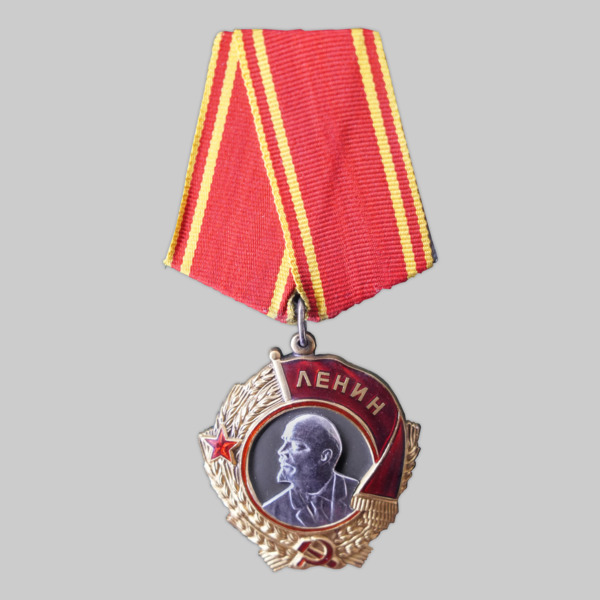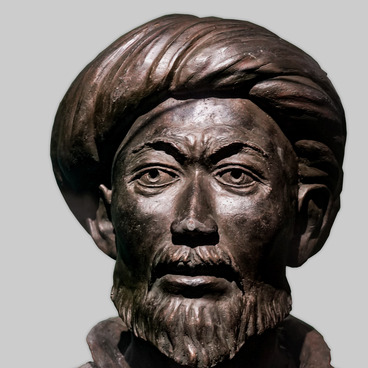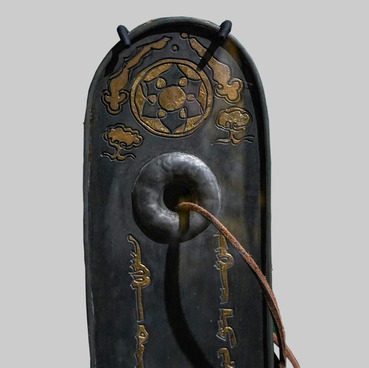On January 3, 1934, the Presidium of the Central Commission of the CPSU (Communist Party of the Soviet Union) awarded the Tatar Republic the Order of Lenin ‘for major successes in the development of agriculture’. The medal is kept in the collection of the Museum of the History of Tatar Statehood and the Republic of Tatarstan.
The Order of Lenin is the highest state award in the Soviet Union. It was awarded to individual citizens, collectives, institutions, enterprises, public organizations and regions of the country for labour and military achievements. The Order was founded in 1930 and newspaper ‘Komsomolskaia Pravda’ became the first laureate for ‘active assistance in strengthening the pace of socialist construction and in connection with the fifth anniversary of its foundation’.
Orders were produced at the printing factory ‘Gosznak’ in Moscow. From 1934 to 1936, the awards were made from 750 gold. The medal was a round medallion portrait with a bas-relief in the centre. The project was made by the artist Ivan Dubasov. As a basis, he took a photograph of Vladimir Lenin which was taken in the summer of 1920 at the Second Congress of the Comintern in Moscow. In the photograph the photographer captured the leader of the proletariat from the left side.
In the upper part of the medallion there is a red flag with the inscription ‘Lenin’, below – a hammer and sickle – symbols of Soviet power and the world communist movement. They signified the unity of workers and peasants and were also located on the state flag of the Soviet Union. The composition was framed by a rim of golden heads of wheat.
In 1934, not only Tatarstan was awarded, but also the leaders and active workers of a number of machine and tractor stations (MTS). Among them are Karim Bairamov (Isanbaevskaia MTS), Sergei Kozhevnikov (MTS of Pestrechinsky district), Sergey Smolov (Mamadyshskaia MTS), Mahmut Bagautdinov (Arskaia MTS).
One of the laureates of the order, Karim Bairamov, was the head of the political department of the Isanbaevskaia MTS. He became a member of the party in 1926. Prior to that, he led the community of local peasants and made a significant contribution to the development of collective farms. During the Great Patriotic War, Bairamov went to the front and upon his return he became a scientific worker and was engaged in teaching work in higher educational institutions of Kazan.
The Order of Lenin is the highest state award in the Soviet Union. It was awarded to individual citizens, collectives, institutions, enterprises, public organizations and regions of the country for labour and military achievements. The Order was founded in 1930 and newspaper ‘Komsomolskaia Pravda’ became the first laureate for ‘active assistance in strengthening the pace of socialist construction and in connection with the fifth anniversary of its foundation’.
Orders were produced at the printing factory ‘Gosznak’ in Moscow. From 1934 to 1936, the awards were made from 750 gold. The medal was a round medallion portrait with a bas-relief in the centre. The project was made by the artist Ivan Dubasov. As a basis, he took a photograph of Vladimir Lenin which was taken in the summer of 1920 at the Second Congress of the Comintern in Moscow. In the photograph the photographer captured the leader of the proletariat from the left side.
In the upper part of the medallion there is a red flag with the inscription ‘Lenin’, below – a hammer and sickle – symbols of Soviet power and the world communist movement. They signified the unity of workers and peasants and were also located on the state flag of the Soviet Union. The composition was framed by a rim of golden heads of wheat.
In 1934, not only Tatarstan was awarded, but also the leaders and active workers of a number of machine and tractor stations (MTS). Among them are Karim Bairamov (Isanbaevskaia MTS), Sergei Kozhevnikov (MTS of Pestrechinsky district), Sergey Smolov (Mamadyshskaia MTS), Mahmut Bagautdinov (Arskaia MTS).
One of the laureates of the order, Karim Bairamov, was the head of the political department of the Isanbaevskaia MTS. He became a member of the party in 1926. Prior to that, he led the community of local peasants and made a significant contribution to the development of collective farms. During the Great Patriotic War, Bairamov went to the front and upon his return he became a scientific worker and was engaged in teaching work in higher educational institutions of Kazan.



